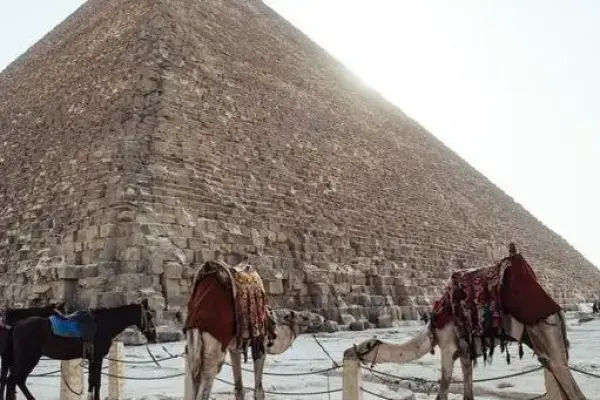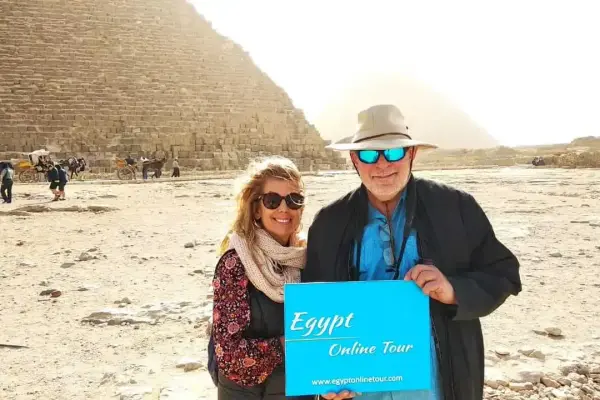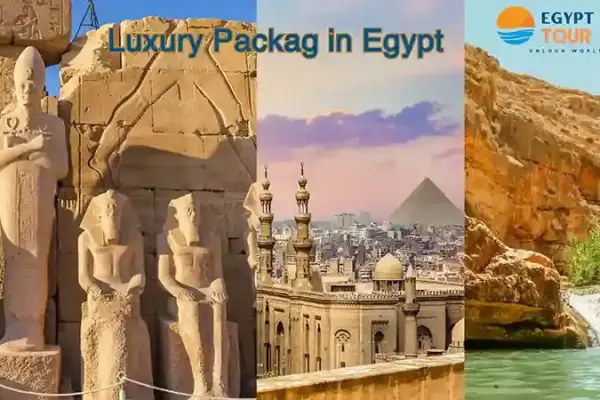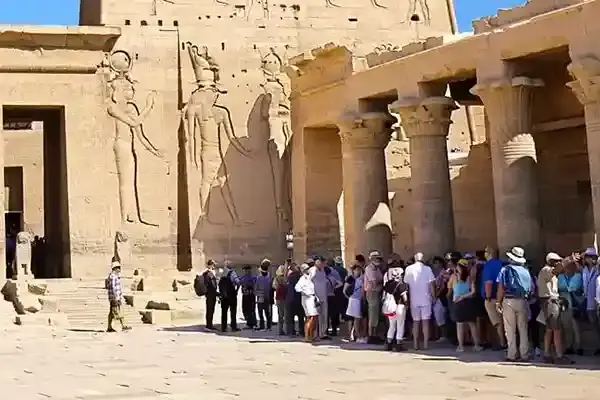Are you familiar with the Black Pyramid - the ancient Egyptian pyramid not crafted with white limestone like the rest? What is black pyramid? Hiding away in the sands of Dahshur, this unknown structure shocked people with its dark color, strange materials, and eerie story. Unlike the height and grandeur of the pyramids at Giza, the Black Pyramid tells a deeper story of ambition, failure and innovation. A neglected story, and a lost treasure in Egypt's tourism and the secrets of its past civilization.
Table of contents [Show]
- The Black Pyramid Discovery
- History Of The Pyramid
- Who Built the Black Pyramid
- The Black Pyramid of Amenemhat III Architecture
- Why is it Called the Black Pyramid?
- What is the Black Pyramid?
- Best Tours to Egypt with Egypt online tour
- The Architecture and Layout of the Black Pyramid
- Pyramidion of Amenemhat III
- Historical Challenges and Collapse
- Location and How to Get the Black Pyramid
- Conclusion
The Black Pyramid Discovery
Did you know that the Black Pyramid was once thought to be a sand dune?
Yes, by God! Until 1850, a German scholar named Karl Lepsius saw it and mapped it, but he still wasn't sure exactly what it was.
But the one who truly uncovered the secret was Dr. Ahmed Fakhry in the 1950s. He entered =the site, began excavating, and we found a surprise.
This wasn't a dune; it was a royal pyramid built by King Amenemhat III, one of the greatest kings of the Middle Kingdom.
They found branching passages, false chambers, and the remains of dark stones around the base.
Since then, the Black Pyramid has remained a mystery that fascinates every researcher and archaeologist.
Today, we look at it not as a ruin, but as an architectural masterpiece that was buried beneath the earth, waiting for someone to explain it.
History Of The Pyramid
The Black Pyramid was constructed during the reign of Pharaoh Amenemhat III (circa 1860 - 1814 BCE), when Middle Kingdom Egypt had reached its pinnacle during the 12th Dynasty. This was')
The Middle Kingdom period likely represents one of the most stable and prosperous eras of ancient Egypt's long history. The Black Pyramid is historical beyond being the tomb of Ahmose; it reflects its time period politically, technologically, and spiritually .
1. Time of Construction and Duration
The construction of the Black clipped pyramid likely started early in Amenemhat III's reign around 1860 BCE, and probably took about 10-15 years for the entirety. This would have been a shorter construction time than thePlatonicSoML , once again relative to the Old Kingdom pyramids, due to the use of mudbrick, instead of compact limestone, which accelerated the construction and would yield a substantial economic benefit.
Excavations at Dahshur completed by the German laureated for finding, or (the German Archaeological Institute), ants other expanded example of the lar encroaching mud brick demonstrated to the layering picture formations in concrete.(Source: TheG/vendors GAI=end of a)
2. Placement Within the Pyramid Timeline
The Black Pyramid marks a transitional phase in Egyptian pyramid construction:
Pyramid | Date (BCE) | Dynasty |
Step Pyramid of Djoser | 2667–2648 | 3rd |
Giza Pyramids (Khufu, etc.) | 2580–2500 | 4th |
Pyramid of Unas | ~2350 | 5th |
Pyramid of Senusret II | ~1880 | 12th |
Black Pyramid | 1860–1814 | 12th |
Pyramid of Hawara | ~1850 | 12th |
Thus, the Black Pyramid is a bridge between the massive stone structures of the Old Kingdom and the more modest but complex Middle Kingdom tombs.
3. Political, Social, and Religious Climate During Construction
Political, Social, and Religious Climate at the Time of Construction
A. Political and Economic Stability
- Egypt was at a point of political unity and centralization because of the reforms of Senusret III, father of Amenemhat III, who was embarking on grand building campaigns in the wider world of great temple and pyramid construction.
- The kingdom was firmly in control of Nubia and traded accordingly with other locations like Punt (Somalia), Lebanon (Cedar) and Sinai (Turquoise).
- Large infrastructure projects controlled by the state, particularly in Faiyum, drove agriculture in Egypt with state-sponsored canals.
- Dieter Arnold remarks in "The Middle Kingdom of Ancient Egypt" that irrigation was planned better than at any time in the past, including the canal systems developed by Amenemhat III under the backdrop of all of the other monumental work in Egypt.
B. Changing Religious Consciousness
- The cult of Osiris became a major royal funerary cult. Although the color black represents rebirth, and it is used for the underworld, it may be no coincidence that a dark casing was used for the pyramid.
- Coffin Texts and proto-Book of the Dead literature became common, for example, as people became more concerned with the individual afterlife.
C. Architectural Developments and Constraints
- With much less skilled labor than in the Old Kingdom building an almost equal pyramid, mud-brick became the only logical alternative.
- Although less durable, mud-brick allowed for more rapid construction, and if constructed properly, later limestone stone casing could embellish the structure.
- While many more pyramids could be constructed when allowed to be mud-brick, they were less externally impressive, but limestone casing only added to the maze of corridors inside to avoid being robbed.
" Administrative texts from the Middle Kingdom, including fragments of the Ebers Papyrus, document resource allocations for pyramid construction and irrigation during Amenemhat III’s reign.
See the reality of the magic within the best Egypt Classic Tours
4. Why This Pyramid, in this Time?
Security from tomb robbers: After the destruction of Old Kingdom pyramids, the new pyramids like that of Dahshur were built in not-so-savvy places based on internal isolation instead of external magnitude.
- Practicality: Mudbrick and more economical building techniques reflected financial realities and logistics.
- Religious meaning: The exterior black surface supports ideas of honoring Osiris; and from a creative view, a sign of resurrection that reflects the relevant theology of the time.
The Black Pyramid stands for the Middle Kingdom commitment to creative architecture. There was so much unfolding during that period — for instance:
- Being politically strong-it was in the Middle Kingdom.
- Being socially ambitious -it was in the Middle Kingdom.
Theology was seeing change, and resurrection more personally and with a directive from God, deification.
The Black Pyramid lives on as a reminder that architecture is more than stone: it is a reflection of civilization's values, aspirations, fears, and dreams.
Read about: How long did it take to build the pyramids
Who Built the Black Pyramid
The Black Pyramid of Dahshur was constructed for Pharaoh Amenemhat III, arguably the most skilled and creative ruler of Egypt's 12th Dynasty when it was constructed during the Middle Kingdom period (reigned circa 1860–1814 BCE). Amenemhat III presided over a 40+ year reign that represented the high point of engineering, architecture, and centralized rule in ancient Egypt.
Who Was Amenemhat III?
Amenemhat III was the grandson of Senusret II and the son of Senusret III, both strong sovereigns who fought for consolidating royal administrational authority of ancient Egypt and opened Egypt up to new blood and influence. Amenemhat III was one of the longest reigning pharaohs and most stable phase of kings in the Middle Kingdom and reigned over a time of unprecedented building, irrigation, and trade.
Notable accomplishments of Amenemhat III:
- Constructed two pyramids- the Black Pyramid at Dahshur and a second pyramid at Hawara, located in the Faiyum region of Egypt.
- Executed an elaborate irrigation system in the faviym depression and increased agricultural capacity for Egypt.
- Promoted trade routes with Nubia, the Levant, and Punt, promoting Egypt's influence as a power in the ancient world.
“From the archaeological volume, the Monuments of Senusret III and Amenemhat III, his reign marked a transformative rethinking of the Egyptian approach to monumentality, with an emphasis on functionality, symbolism, and experimentation.'
Read about: Did Thoth Built The Pyramids
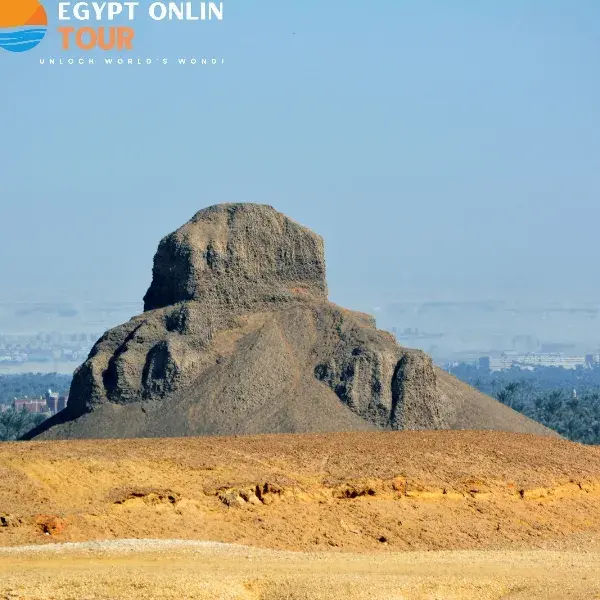
The Black Pyramid of Amenemhat III Architecture
After the missed mark of pyramid endeavours made by his predecessor at Dahshur, Amenemhat III was determined to adopt both new designs and new materials, in the conception of pyramid based architecture.
A. Black Pyramid Design Features:
- Location: The Black Pyramid is located at Dahshur slightly south of the Saqqara royal necropolis.
- Core Material: Built with mostly mudbrick which are a faster and lighter building medium than limestone.
- Casing: Casing of a dark limestone, possibly basalt, which is imposing and somber in regard to color.
- Interior Design: Generally, pyramids had no interior chambers, unlike the Black Pyramid which was designed with chambers and a complicated series of passageways with strong deterrence to tomb robbers. Also, the inclusion of burial chambers for royal women is an innovation in earlier pyramids.
- Read about: Strange Facts About The Pyramids
B. Innovations and Purpose of Design:
- Amenemhat adjusted the inclination of the pyramid sides from earlier standard angles used in order to establish some degree of reliability of stability after structural weakness/failure prior.
- Mudbrick instead of heavy stone is economically viable and dramatically reduces construction time.
- Darkness potentially had religious connections with Osiris and rebirth, especially reflecting the need for a king to advance in the spiritual rebirth and transition.
" Excavations by the German Archaeological Institute at Dahshur reveal both inscriptions and funerary vessels inscribed with Amenemhat III's name, confirming ownership of the pyramid. (Source: GAI Reports on Dahshur, 2002–2015)
4. Comparing His Two Pyramids
Feature | Black Pyramid (Dahshur) | Hawara Pyramid |
Material | Mudbrick + dark limestone/basalt | Mudbrick + white limestone |
Design | Modified slope for stability | Included the Labyrinth temple complex |
Purpose | Royal tomb | Tomb + administrative/religious center |
Amenemhat III is considered one of the most innovative pharaohs in Egyptian history for several reasons:
- He pioneered new architectural solutions to the problems faced by earlier pyramid builders.
- His projects merged spiritual symbolism with practical design, as seen in the Black Pyramid’s layout and color.
- He built structures like the Labyrinth, which served both ceremonial and governmental functions.
- His advancements in engineering and state infrastructure left a lasting legacy that influenced Egyptian architecture for centuries.
Today, a visit to Dahshur via Luxury Egypt Tours reveals the weathered remains of the Black Pyramid, a testament to a king who dared to experiment—blending religion, engineering, and royal ambition into one of the Middle Kingdom’s most enduring monuments.

Why is it Called the Black Pyramid?
The name 'Black Pyramid' likely comes from the dark hue of its weathered exterior, which emerged over time as the structure aged from its original design. While the dark appearance of the visible structure is impressive, it was likely not intended to look that way.
1. Construction Material:
The outer casing was likely made from either dark limestone or black basalt, which is a volcanic rock commonly used in style or construction in Egyptian architecture. It is unclear whether the dark material was symbolic or practical; either could be possible. What we do know is over time or usage through construction, the outer casing has eroded, with only the mudbrick core remaining. The remaining core has become darker over centuries of weathering, salts, and decay, which has lent to the currently visible attribute.
2. Religious Symbolism:
In ancient Egyptian thinking, black had significant symbolic meaning. Black associated with fertility, initiation, the god Osiris, king of the underworld, and black also referenced the personified mythological Benben stone, which is a revered stone from the egg which gave birth to life (or recursion to evolution). Some Egyptologists would argue that royal usage of dark material as casing could reference the aspiration to gain everlasting life, and a divine transformation to suggest the continuing theme in Egyptian architecture.
3. Natural Weathering:
Other scholars, including references in the German Archaeological Institute’s excavation reports, argue that the color may have resulted, and even evolved, from numerous chemical change processes over time. For instance, exposure to moisture and oxidation can stain or darken limestone, especially when it’s weathered, partially encased, or poorly preserved.
Historical and Archaeological Evidence:
Despite the lack of clear contemporary inscriptions naming the structure as the "Black Pyramid," several archaeological clues support its identity:
- Excavations at Dahshur have unearthed fragments of dark-colored casing stones, lending credence to the theory of an original black exterior.
- Medieval Arab historians, such as Al-Maqrizi, described unusually dark or "blackened" pyramids in the Dahshur region, though without precise identification.
No direct references in Pyramid Texts explicitly mention a black pyramid, but the symbolic importance of color in mortuary architecture is well-documented.
What is the Black Pyramid?
The Black Pyramid is an ancient Egyptian pyramidal structure that is both culturally and historically significant, located in the Dahshur necropolis just south of modern-day Cairo. The Black Pyramid is usually overshadowed in popular literature by the Giza pyramids, and is believed to have been built during the Middle Kingdom period, during the reign of the Pharaoh Amenemhat III of the 12th Dynasty (ca. 1855-1808 BCE). There has been some confusion in early literature about the name of the important pharaoh who was responsible for the construction of the Black Pyramid, as most scholars now believe that Amenemhat III, and not Amenemhat II, should hold this honour—see The Complete Pyramids by Mark Lehner.
Notable Characteristics:
- Material: The Black Pyramid pyramid was built largely in mudbrick, the most common building material of the Middle Kingdom, and the outer casing was made of a darker limestone or possibly of black basalt. The external casing of the Black Pyramid was one of the more unusual aspects of this pyramid; it resembled a low-angled, lower pyramid rather than the tall and steep pyramids of the Old Kingdom, which were almost always made of white limestone.
- Design & Shape: The Black Pyramid pyramid does not have the towering heights, or sharp angles as the later pyramids at Giza and it had a more shallow slope over its low height. The Black Pyramid pyramid followed an increasingly complex internal multi-chambered burial site, with various burial chambers and corridors - some even meant for royal women - and the use of open air chambers was an innovation at the time.
- Current State: Today, the pyramid appears heavily eroded and partially collapsed. Its outer casing has been stripped or disintegrated over centuries, revealing the dark mudbrick core underneath. This exposed core gives it a black or dark appearance, which has led to its modern name.
Comparison with Other Pyramids:
| Feature | Black Pyramid (Amenemhat III) | Classical Pyramids (e.g., Khufu) |
| Color | Dark/Black (due to materials/erosion) | White (polished Tura limestone) |
| Core Material | Mudbrick | Limestone and Granite |
| Purpose | Funerary with religious symbolism | Funerary, aligned with stars |
| Structural Form | Lower and broader, complex chambers | Tall, symmetrical, centralized burial |
The Black Pyramid represents the architectural and spiritual capabilities of Middle Kingdom Egypt. The blackened ruins not only show the effects of time and erosion, but also give possible insight into its intended religious meaning. While many details are obscured by centuries of deterioration, current excavation work is still revealing more about the compelling story of one of Egypt's most enigmatic pyramids, So don’t miss the chance to see it by Egypt Adventure Tours .
Best Tours to Egypt with Egypt online tour
Are you planning to visit Egypt and enjoy seeing its historical landmarks and the Black Pyramid?
You must try Egypt Online Tour company.
From your arrival until your return, we will arrange everything for you:
- Comfortable transportation
- Top-rated hotels
- Tickets, temples, and historical sites
- Nile cruises
- Desert safaris
And even if you need a day off in Sokhna or Hurghada, we're here for you.
With us, you won't just visit the places, you'll experience them.
With skilled guides, flexible plans, and prices that compete with any other company.
We're not just a travel company...
We'll make your trip to Egypt one of the most beautiful memories of your life.
Contact us now and book your trip with Egypt Online Tour.
And get ready to say, "Wow, that was the trip of a lifetime!"
Let our local travel experts help you design the perfect itinerary. Whether you're seeking adventure, culture, or relaxation, we've got you covered!
The Architecture and Layout of the Black Pyramid
The Black Pyramid of Amenemhat III stands as one of the most architecturally daring and symbolically rich pyramids of ancient Egypt. It reflects a radical departure from Old Kingdom traditions, not just in materials and design, but also in purpose and ideology.
1. Exterior Description: Shape, Size, and Materials
Location: The pyramid is located in Dahshur, south of Saqqara, on the west bank of the Nile—a traditional burial ground for Egyptian royalty.
Original Dimensions:
- Height: Approximately 75 meters (smaller than Khufu’s pyramid but among the tallest of the Middle Kingdom).
- Base Length: Around 105 meters on each side.
- Slope Angle: Estimated at 55°, less steep than Khufu’s 51.5°, designed to prevent structural failure.
Outer Appearance
- Originally covered in black or dark limestone—possibly basalt—giving the pyramid its distinctive dark color.
- Today, it appears as a dark, crumbling mound, due to the erosion of the mudbrick core after the casing stones were lost.
Measurements by the German Archaeological Institute in the 1980s confirm these dimensions and provide insight into the degraded state of the structure.
2. Interior Layout: A Maze of Deception and Protection
Unlike earlier pyramids with relatively simple corridors, the interior of the Black Pyramid is a masterclass in funerary security—a network of decoy passages, traps, and cleverly hidden burial chambers.
A. Hidden Southern Entrance
- The entrance is unconventionally placed on the south side, contrasting with the northern entries of Old Kingdom pyramids.
- This strategic decision was likely made to mislead tomb robbers.
B. Complex Passageways
- Descending Passage: Initially leads into false side rooms—a deliberate misdirection.
- Trap Chambers: Include dummy doors, fake walls, and blocked passages designed to confuse intruders.
- Ascending Passage: Eventually leads to the main burial chamber, high within the pyramid’s core.
C. The Burial Chamber
- Constructed from red quartzite, an extremely hard and durable stone, rarer than granite.
- Supported by massive limestone beams, designed to distribute structural stress and prevent collapse.
- The sarcophagus was found empty, likely plundered in antiquity.
The interior map of the pyramid was first published by Egyptian archaeologist Labib Habachi in the 1950s, and later confirmed by GAI excavations.
Feature | Black Pyramid (Amenemhat III) | Typical Old Kingdom Pyramids (e.g., Khufu) |
Core Material | Mudbrick | Limestone |
Casing Material | Black limestone or basalt | White limestone |
Passage System | Labyrinthine with traps and decoys | Straight corridors |
Burial Chamber | Red quartzite, high-tech stonework | Simpler, often lower in structure |
Entrance Orientation | South (hidden) | North-facing |
Religious Focus | Osiris (rebirth, underworld) | Ra (sun god, cosmic order) |
The architecture of the Black Pyramid is deeply symbolic:
- The dark casing echoes the color of Osiris, god of the underworld and rebirth, possibly serving to connect the pharaoh with divine resurrection.
- The internal complexity may reflect beliefs in spiritual trials, mimicking a journey through the underworld.
- Use of advanced construction techniques (e.g., reinforced ceilings, hidden chambers) shows how religious and architectural goals merged.
As stated in the National Geographic documentary "Secrets of the Black Pyramid," the layout of the pyramid tells us as much about ancient Egyptian theology as it does about engineering.
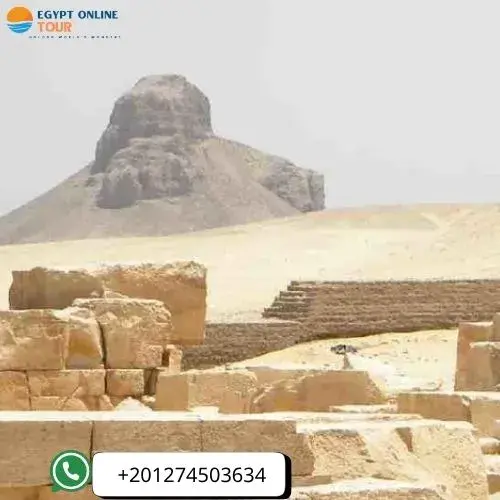
5. Why Is the Black Pyramid Considered a Masterpiece?
- It broke from tradition, embracing innovation in design, materials, and purpose.
- Its labyrinthine interior was a leap forward in funerary security.
- It emphasized symbolism over spectacle, favoring spiritual depth over visual grandeur.
- It marks a turning point in the history of pyramid construction—from monumental to metaphysical.
“The Black Pyramid is not just a tomb—it’s an architectural declaration of a new era.”
— Dr. Zahi Hawass
Pyramidion of Amenemhat III
The Black Pyramid of Amenemhat III stands as one of the most ambitious and experimental constructions in ancient Egyptian history. While it represents a significant step forward in symbolic and architectural design, it also reveals the engineering risks of innovation. This section examines the pyramid’s missing capstone (pyramidion), the materials and techniques used in its construction, and the reasons behind its structural failure.
1. The Pyramidion: The Missing Capstone
The pyramidion (also called the capstone) is the pointed stone that once crowned the top of the pyramid. In ancient Egyptian belief, the pyramidion had profound religious symbolism:
- Spiritual Role: It symbolized the connection between the pharaoh and the sun god Ra, marking the pyramid as a stairway to the heavens.
- Material and Design: Pyramidia were often made of limestone, basalt, or granite, and sometimes gilded to reflect sunlight.
- Decorative Inscriptions: Some pyramidia were engraved with solar hymns, depictions of Ra, or Pyramid Texts.

Was the Black Pyramid’s pyramidion ever found?
There is no confirmed discovery of the Black Pyramid's capstone. However:
- Some scholars suggest it might have been crafted from dark basalt to match the pyramid's exterior.
- It may have collapsed with the upper structure or was looted in antiquity.
- Excavations in Dahshur have uncovered fragments of pyramidia from the 12th Dynasty, including those possibly linked to Senusret III.
Reference: “The Pyramid Complex of Amenemhat III at Dahshur”, German Archaeological Institute
2. Materials and Innovative Construction Techniques
Amenemhat III’s architects utilized unconventional materials and introduced new architectural strategies to adapt to the changing needs and resources of the Middle Kingdom.
Core Material: Mudbrick
- Composed of Nile silt mixed with straw, mudbrick was abundant, cheap, and easy to mold.
- It greatly reduced construction time (estimated 10–15 years for the Black Pyramid).
- However, mudbrick is highly vulnerable to moisture, erosion, and weight stress.
Outer Casing: Dark Limestone or Basalt
- Intended to protect the core and reflect the pyramid’s symbolic black appearance.
- Stones may not have been tightly fitted, contributing to later structural instability.
Burial Chamber: Red Quartzite
- A rare, hard stone used for the king’s sarcophagus chamber.
- Shows a focus on security and durability for the pharaoh’s afterlife journey.
New Architectural Features
Feature | Description |
Layered Chambers | Series of rooms above the burial chamber to disperse weight effectively. |
Southern Entrance | Unconventional placement to mislead tomb robbers. |
Sand Traps and False Doors | Designed to delay or confuse intruders. |
Clay and mortar samples analyzed by the University of Cairo confirm the use of a unique mud mixture in Dahshur.
3. What happened to Amenemhat III pyramid?
While visionary, the pyramid's bold experimentation came at a cost. It began to deteriorate only a few centuries after its construction—a rare failure for an ancient Egyptian royal tomb.
How Did the Black Pyramid Get Damaged?
- Likely started during the New Kingdom period (~1500 BCE), around 500 years after its completion.
- The casing stones detached, and the mudbrick core eroded rapidly, causing partial collapse.
- The upper part, including the pyramidion, was completely destroyed.
Why Did It Fail?
Cause | Explanation |
Weak Core Material | Mudbrick could not withstand long-term exposure to moisture and wind. |
Unstable Ground | Dahshur sits on sandy and high-water-table soil, which may have undermined the foundation. |
Inadequate Casing Anchoring | Stones may not have been properly bonded to the mudbrick, making them easy to dislodge. |
Sharp Slope Angle (55°) | Increased pressure on the lower structure, especially risky with soft core materials. |
Lack of Drainage | Rainwater pooled around the base, accelerating erosion. |
Reports from the German Institute’s geological team show evidence of foundational cracks and subsidence.
Environmental and Human Factors
- Heavy rains, though rare in Egypt, are enough to erode mudbrick.
- Windblown sand and salts from the Nile caused chemical degradation.
- Looting and the absence of ongoing maintenance worsened its condition.
Ramesside-era texts mention the “fall of the dark stones of the southern pyramid,” possibly referencing this structure.
“Was it a failure? Structurally, perhaps. But ideologically, it marked the future of royal funerary thinking.” — Dr. Dieter Arnol
Historical Challenges and Collapse
Although the Black Pyramid of Amenemhat III was built over 3,800 years ago, its architectural and religious significance continues to live on. This chapter explores its preservation through time, how to visit it today, and what makes the experience so unique beyond traditional tourist routes.
Restoration Attempts Over the Years
During the Roman Period, the pyramid served as a quarry. Many of its casing stones were repurposed for nearby buildings.
▪ Modern Efforts (20th–21st Century)
1980s–1990s: The German Archaeological Institute led pioneering preservation efforts:
- Structural mapping of foundation cracks and wall stress.
- Stabilization of remaining black casing stones.
- Installation of temporary supports to prevent further collapse.
2010s–Present:
- Egypt's Ministry of Antiquities closed several inner corridors due to structural risk.
- Geophysical surveys were conducted to monitor soil and ground stability.
Location and How to Get the Black Pyramid
▪ Geographic Coordinates
- Southern Dahshur, west of the Nile, about 40 km south of central Cairo.
- Coordinates: 29°48′N, 31°14′E
▪ Nearby Monuments
- 3 km from the Bent Pyramid.
- 10 km north of Unas Pyramid in Saqqara.
Private Car: ~1 hour Via Cairo–Fayoum Road
Organized Tour: Full-day Offered
Tip: Arrive early in the morning for the best light and mild weather.
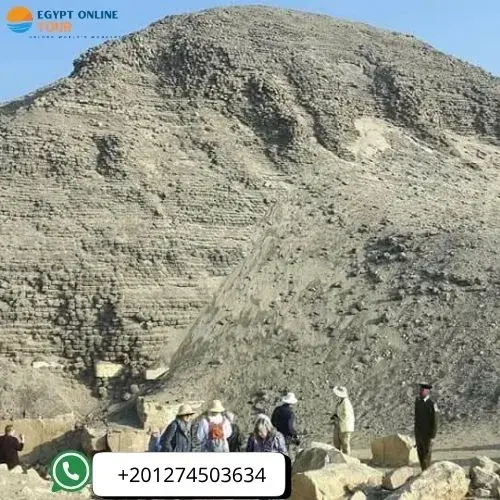
What to Expect While Visiting the Black Pyramid Today
Current Access
- The pyramid is partially open to the public.
- Inner passage access is allowed with licensed guides.
Highlights
- Section
What You'll See:
- Exterior: A dark, eroded structure with remnants of black casing
Interior: Narrow passages, false chambers, sand traps, faded inscriptions of Amenemhat III
Visitor Guidelines & Safety Tips
- Photography (no flash)
- Touching walls or stones
- Entry with certified guide
- Carrying large bags inside the pyramid
- Walking open corridors
- Writing or scratching on walls
Caution: Slippery surfaces due to loose sand. Wear sturdy shoes and carry a flashlight.

What Can You See During a Visit?
▪ Outside: Resembles a dark sand hill in the desert, contrasting with nearby pyramids.
▪ Inside: Low lighting reveals smart architectural tricks.
Remains of the stone sarcophagus in the burial chamber.
Recommendation: Bring a flashlight to appreciate the interior design.
Discovery & Scientific Study
▪ Discovery Timeline
1850s: Described by Karl Richard Lepsius as a natural hill
1950s: Identified as a pyramid by Dr. Ahmed Fakhry
Dr. Dieter Arnold: Led excavations (1976–1983)
Dr. Zahi Hawass: Conducted geophysical assessments in 2007
Published in the Journal of Egyptian Archaeology and Cairo University archives.
Read about: Best time to travel to Egypt
Is the Black Pyramid Open for Tourists?
Yes, ofcourse and here you are best Recommended Tours
- Day Tour: Dahshur + Saqqara + Fayoum
- Private Heritage Tour, Focused on lesser-known pyramids
Make sure your tour includes access to the internal chambers!
If you're ready to experience this fascinating monument in person, Egypt Online Tour offers exclusive guided visits to Dahshur, including the Black Pyramid, Bent Pyramid, and the Red Pyramid — all in one unforgettable day. With expert Egyptologists, comfortable transportation, and unbeatable prices, it’s the perfect gateway to explore ancient wonders beyond the usual path.
Learn more about: How to Spend Summer Vacation in Egypt
Why Visit the Black Pyramid?
- Explore a unique architectural marvel that dared to defy tradition.
- Witness the intersection of religious symbolism and engineering risk.
- Enjoy a quiet, reflective experience far from crowded tourist sites.
"The Black Pyramid is not a ruin; it is a statement. A broken whisper from a king who dared to dream differently." — Dr. Dieter Arnold
Go and read about: How to Plan a Trip to Cairo Egypt
Conclusion
The Black Pyramid of Amenemhat III stands not just as a ruin from the sands of time, but as a bold architectural and religious statement from one of ancient Egypt’s most visionary kings. Though weathered and partially collapsed, it continues to whisper the secrets of Middle Kingdom ingenuity, symbolic ambition, and spiritual transformation.
Far from the crowds of Giza, the Black Pyramid offers a unique and intimate encounter with a lesser-known masterpiece — a site where innovation met reverence, and where failure itself became a legacy of learning.
Popular Categories
Popular Posts

Top Alexandria Beaches You Must Visit 2026

The Egyptian Museum in Cairo | Ancient Treasures



